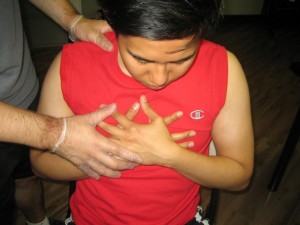Pulmonary embolism is the abrupt obstruction of a major blood vessel or the artery within the lungs, usually a blood clot. The clots are insignificant and not dangerous, but can damage the lung. The usual cause of obstruction is a clot found in a deep-seated vein in the leg and spreads to the lungs and lodges in one of the small arteries in the lungs. It can also form in the deep veins of the pelvis or arms.
Causes of pulmonary embolism
- Air bubbles or substances that gets into the blood due to trauma, medical procedures or surgery.
- Small masses of infected materials
- Fats that are released to the bloodstream due to fractures of the bone, trauma, severe burns and surgery.
- Tumors caused by fast growing cancer cells
A sudden severe chest pain that becomes worse with deep breathing or coughing
Symptoms
- Fast heartbeat and breathing
- Sweating
- Anxiety
- A sudden severe chest pain that becomes worse with deep breathing or coughing
- Coughout out blood or pink and foamy mucus
- Fainting and heart palpitations
- Signs of shock
Symptoms of pulmonary embolism have similarities to other conditions such as asthma, heart attack, pneumonia and panic attack. In some cases, there are no symptoms.
Treatment
- If the affected person has very low oxygen levels, he/she is given a higher flow of oxygen through a mask. When experiencing shortness of breath, a ventilator is used where a large tube is placed into the trachea and attached to the breathing machine.
- Perform exercises for proper flow of blood in the legs. Point the toes toward the head so that the calves can be stretched.
- Stop smoking
- Wear compression stockings to prevent the development of deep vein thrombosis in the leg.
Tips
- Regular use of prescribed anticoagulant medication to prevent recurring pulmonary embolism by preventing the formation of new blood clots.
- Encourage movement after surgery.
- Prevent formation of blood clots during travel by drinking fluids and walking around every hour. Avoid inactivity for long periods to prevent the risk of blood clots.
- Stop at least every 2 hours on a car trip by stretching the legs and taking a walk around for a few minutes.
- If an individual is susceptible to pulmonary embolism, seek medical help before taking a long flight or a car trip so that any precautions to prevent blood clots when traveling can be given by the doctor.

